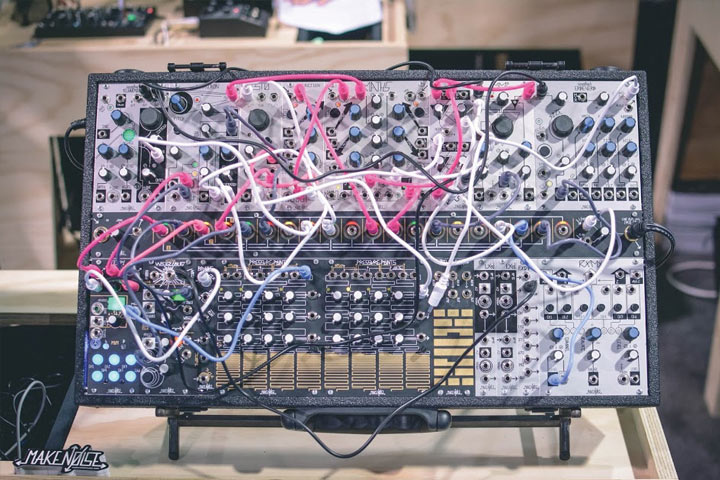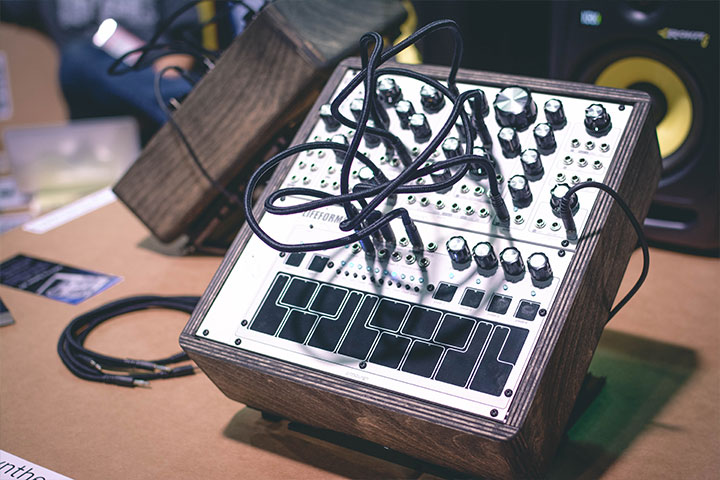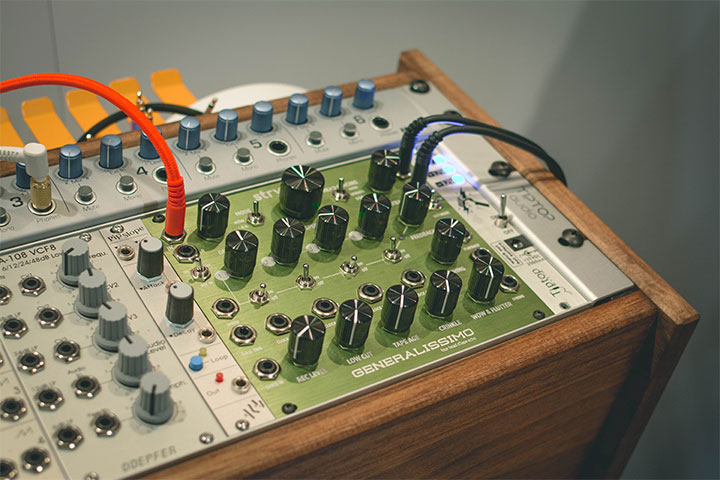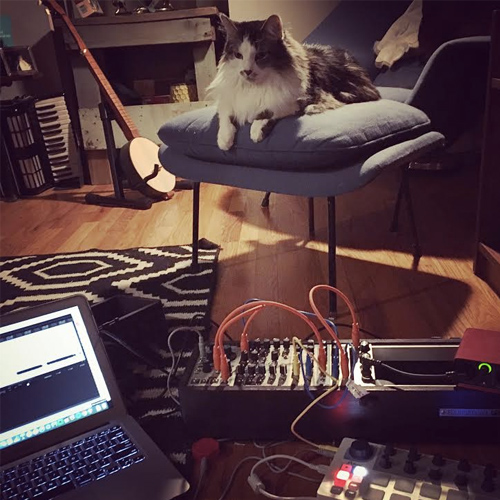If you had the chance to visit the NAMM show this past January, you probably noticed the expanse of Eurorack synth manufacturers on display front and center by the main entrance to the convention. A handful of Eurorack companies have exhibited at NAMM in past years but were relegated to the basement as an afterthought, to be visited later and only if you found time. This year, the Eurorack community was an unmissable centerpiece with dozens of makers cobbled together like the modules in their massive Eurorack displays.

Make Noise Erbe-Verb synthesizer module

Pittsburgh Lifeforms synthesizer module
Like other industry insiders at the show, I held a basic comprehension of the Eurorack concept. I knew that Doepfer introduced the rack format in the '90s, which in the past few years has exploded in a pangea of boutique builders producing modules that perform the individual functions of various parts of an analog synthesizer. This growing galaxy of modules has given synthists the ability to assemble systems that satisfy their unique sonic needs. I own a couple of keyboards and posses a basic understanding of analog synth architecture, but remained otherwise ignorant of the intricacies of the circuits and the specifics of the community that define Eurorack production and performance.
Gliding through the maze of Eurorack booths and avoiding the similarly bearded denizens locked into their patches and headphones, I felt a familiar thirst to understand this world. While the endless arrays of wires and knobs were intimidating to a tepid outsider who had spent most of the weekend talking about guitars and pedals, one thing was clear: Eurorack is a fresh and verdant subsection of the industry that cuts through the derivative musk that surrounds things like guitar gear. It's a wellspring of musical and technological innovation, and one that I needed to get in on.
Getting into Eurorack: First Steps
Returning to Chicago post-NAMM, I set about building my very first Eurorack synth. I watched a string of YouTube videos and interrogated some Reverb officemates who already understood the technology. I learned that a VCO module by itself produces noise and that I needed things like a VCA, an envelope generator and a controller to actually do anything with it. I won't get too deep into the ins-and-outs of the synth building blocks here, but for a stellar overview, I recommend taking a look at this Reverb video and article on synth fundamentals.
Before any of this could occur, of course, I needed to raise some funds. Make no mistake: Eurorack is an expensive hobby, which is a by-product of small-volume independent production as well as the built-in expense of many of the materials used to craft things like oscillators. While individual modules can come in at less than $100 for basic functional pieces, to get an entire system up and running, you're looking at closer to $1,000, which is enough to buy any number of all-in-one synths like a Korg Minilogue or an Arturia Microbrute.
As the used Eurorack market expands, I anticipate the monetary barrier to entry to decrease. For me, I was able to fund this project the best way I know how: by selling guitar gear. I combed through my Chicago practice space for unused pedals, sold them all on Reverb and earned enough scratch to let the synth building begin.
Eurorack from the Pedalboard Perspective
Selling a dozen guitar pedals for the sake of buying boutique synth equipment represents an obvious personal and musical transition. But I pause to note the myriad similarities between the two. Both pedalboards and Euroracks are modular musical formats with endless potential for expansion. Both markets are flush with a growing list of boutique designers pushing the envelopes of their medium, and interest in either endeavor represents an obvious and possibly clinical abandonment of personal financial responsibility.

Strymon Generalissimo Eurorack dTape Echo
The differences between the two worlds, however, are just as important when considering if Eurorack is right for you. A pedalboard is really just an extension of an instrument -- you don't need a delay pedal for your guitar and amp to produce sound. With a Eurorack, you're not extending an instrument; you're building one, and the various components are actually what produce the fundamental frequencies. Yes, there are countless effects modules in the Eurorack format (including a recently launched delay from pedalhead favorite, Strymon), yet the more important pieces when starting out are your VCO and other signal-flow essentials.
Of course, it's misleading to pose pedalboards and Euroracks as at all diametric when in reality the two toolsets are actually quite complementary. This I've already illustrated by plugging my novice Eurorack into my Death by Audio Ghost Delay and custom-built NoiseKick FXReverb pedal, which flawlessly accomplished the short-term goal of scaring the hell out of my cat.
The First Eurorack Purchases
Once you've made the decision to wander down the Eurorack rabbit hole, there are a few key first steps. No matter kind of system you want to build, you'll need a case and a power supply. I was lucky enough to snag a listing on Reverb for a used Pittsburgh Modular Move case that fulfilled both needs. From there, I recommend looking at other Eurorackers' systems to see what modules they've selected and how everything is are arranged. For a shortcut into the world, you can also consider an all-in-one Eurorack-able synth like the Moog Mother-32, or even keep an eye out for a listing of someone else's completed system.
Admittedly, my first purchases were based more on finding decent deals on used modules than any calculated musical intent. I knew, for example, that I needed a filter so I jumped on a used WMD Micro Hadron Collider listed on Reverb rather than endlessly researching the filter that would best suit my tastes. But that's the beauty of a modular system. I can use this filter to get off the ground and always swap in something else later. When that occurs, I plan on recouping my funds by selling the WMD unit on Reverb. It's a play I've run to justify my pedal habit over the years and proves just as effective with modular.
Vital Resources for Getting into Eurorack
Eurorack and analog synthesis in general are realms best learned by getting your hands dirty and experimenting, but before you start patching and knob twisting, you should take some time to familiarize yourself with what's out there. Here are a few key resources to do so:
Modular Grid
As someone who has spent much of my adult life researching music gear on the internet, I can confidently say that ModularGrid.net is one of the best gear websites out there. This robust index of modular info includes an interactive rack planner where you can select and arrange modules to plan your builds. For my own purposes, it allowed me to draft my synth ideas and share them with my Euroracking mentors to make sure everything would work as intended.
MuffWiggler
The Eurorack community is largely centered in Portland, OR, and one of its central pillars is the MuffWiggler site. This highly active gear forum contains more opinion and discussion on synths and Eurorack than anywhere else online. If you search for Eurorack topics on Google, you're likely to end up on one of their pages, and if you have questions about your setup, this is the place to make a post.
Reverb Price Guide
I include Reverb in this list somewhat aspirationally and as a promise of things to come. As part of the expansion of the format, here at Reverb we're doing what we can to follow and encourage the used market. If you peek at our Price Guide, you'll see listings for many of the major Eurorack companies and modules, with basic information as well as pricing history on used sales that have occurred in our marketplace. Of course, Reverb is my preferred place to buy Eurorack components, yet you can also find used sales on forums and other classified sites.
Putting It All to Use

And now, after all is said and done, I have a functional Eurorack synth and am left with the task of actually doing something with it. This is, of course, the exact same challenge I've faced in my years of pedal buying and guitar trading, so it's an anxiety I'm already equipped to combat.
What's different this time around is the renewed sense of exploration that comes with total ignorance of an instrument. Just like the first time I picked up a banjo and plucked out a few chords, there's a creative bliss that comes when exploring an instrument you know little-to-nothing about. When you play guitar, there's that little voice in your ear saying "that lick was used on that one song already" that comes from a lifetime of repertoire building. The voice does not exist when playing a totally unique synth you've built for yourself.
From here, the plan's to keep building and exploring; to record the most interesting patterns and layers with my trusty 2i2 and maybe folding some drum and guitar parts over the top. I don't anticipate earning too many Bandcamp listens from doing so, but that doesn't really matter in the face of the new sense of discovery I feel in my fingers. We'll see how long the hobby lasts, but for now, I'm off to compare some more modules.
